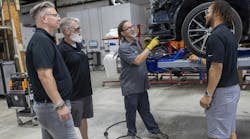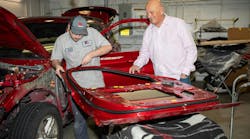The sun shines bright in Hawaii all 12 months of the year, sometimes beaming for 16 hours in a single summer day. And while many simply enjoy the warmth, Carl Vincenti saw a different plan for Oka’s Auto Body—harnessing the sun to power the shop.
“Going through the processes and looking at the energy costs in Hawaii, which are considerably more than the most expensive energy in the mainland, we wanted to reduce our own carbon footprint substantially,” Vincenti says. “Photovoltaic (solar energy) was coming into its own ... so we contacted the state to find out what energy programs they might have available to a small business.”
Oka’s Auto Body
Waipahu, Hawaii
Size: 25,000 square feet
Staff: 24 (8 body techs, 4 painters, 3 detailers, 3 appraisers, 2 parts managers, 2 customer service representatives, 1 general manager, and 1 owner)
Monthly Car Count: 110
Annual Revenue: $3 million
Back in 2008, solar power installations weren’t exactly prevalent. Only a few thousand businesses and homes had utilized the relatively new alternative to electricity, with the installed photovoltaic capacity in the U.S. averaging around 400 megawatts in 2008, according to the Solar Energy Industries Association (SEIA). Today, there are over 17,500 megawatts of cumulative solar electric capacity operating in the U.S., which is on pace to complete its millionth photovoltaic installation in 2015.
Yet, very few businesses actually utilize solar power. Although the environmental benefits are obvious, many businesses have to wonder: Do the long-term benefits outweigh the initial cost of going photovoltaic?
It’s a question Vincenti, director of business development, and the team at Oka’s Auto Body, located in Waipahu on the island of O’ahu, had to consider. And with the fairly expensive photovoltaic industry still gaining an identity in 2008, it took two years of research to find an answer.
The Backstory
As energy costs were rising in Hawaii, Oka’s Auto Body, a local leader in environmentally safe business practices, was looking for ways to save on costs. With solar energy’s popularity on the rise, photovoltaic became a focus.
“We had to ask: How are we going to amortize our costs of putting in a system? What are the benefits to our business as to what we can afford?” Vincenti says.
Vincenti contacted Hawaii’s State Energy Office, which referred him to an association comprised of photovoltaic industry professionals. The executive director of the association referred the shop to several companies for estimates.
That’s where it got difficult.
The Problem
With photovoltaic industry blossoming, the number of start-ups was daunting, says Vincenti. Very quickly, every new solar energy company wanted to show Oka’s Auto Body how much it knew and give a tutorial on photovoltaic. However, many of the companies were not brick and mortar—nothing more than an energy consultant answering a cell phone.
“Every plumbing company that was doing solar water wanted to do PV, and every electrical company that was being contracted to install the electrical for the systems wanted to add a division to do photovoltaic,” Vincenti says. “There were 100 new companies every month. And some of them had zero experience in putting in photovoltaic systems, had zero relationship with vendors who do inverters or micro inverters or panels.”
Vincenti determined through discussions with photovoltaic installation companies that Oka’s 25,000-square-foot facility warranted approximately 500 solar panels. The dozens of companies contacting Vincenti would provide estimates that ranged from $500,000 to over $1 million.
“Initially, I'm being quoted on one sheet of paper from one company to a booklet that's as thick as an encyclopedia from another company,” Vincenti says. “There’s something wrong there. The industry just hadn’t come into its own, hadn’t weeded out the companies that didn’t know what they were doing. There’s no logical reason for that large of a discrepancy in pricing.”
So instead of settling for one of the hundreds of photovoltaic companies, Vincenti decided to educate himself on the industry and ways of reducing costs.
The Solution
While Vincenti was researching the various photovoltaic companies in Hawaii, he was contacting the shop’s bank for programs that had advantages in the solar energy market.
Vincenti also contacted Oka’s personal certified accountant, who researched what sort of tax advantages were available for photovoltaic installations. But since accountants at the time weren’t well-versed in the freshly instated solar energy industry, the shop also sought tax benefit advice from its tax attorney and Hawaii Rep. Tulsi Gabbard, who chaired the state energy board.
Eventually, years of continued research, self-education, and patience paid off. Hawaii added corporate tax credits for solar and wind energy of 35 percent for the equipment and installation of a photovoltaic system, in addition to a 30-percent tax credit offered by the federal government.
That’s right: in total, a 65-percent tax credit.
In addition, the state government started offering performance-based incentives for photovoltaic projects, which could receive a fixed, decreased rate on kilowatts used per hour over a 20-year contract.
On top of it all, with solar energy capturing the government’s attention and gaining in popularity, photovoltaic system installation costs decreased from $7.50 to $5.90 per watt between 2008 and 2010, according to the SEIA.
“We looked at it as reducing our carbon footprint and being good to our community at the beginning, and then we started to realize, ‘Jeez, this could actually save us money, be a good business step and reduce our overhead as to what we pay for energy,’” Vincenti says.
The Aftermath
After two years of research and planning, Vincenti invited 10 companies to give presentations. Then Oka’s narrowed it down to two companies, each of which gave presentations to the management staff, the bookkeeper, the tax attorney, and the accountant.
The shop landed on a company called Hawaii Energy Connection, which was offering a 25-year warranty on the panels, a 25-year warranty on the equipment, and a price tag of $450,000, which, after the tax credits, cost Oka’s just under $200,000. On top of it all, the company agreed to work on the weekend, as to not interfere with day-to-day operations.
Since installing the photovoltaic system, which consisted of 450 panels, the shop’s energy usage has been zeroed out. While the summer months produce more sunshine, Oka’s is able to produce 110–120 percent of its maximum power usage and store it up for the colder, rainier winter months.
Since the shop doesn’t have a battery storage system (it’s too expensive), Oka’s still pays a fee to hook up to a grid that manages the energy. However, the long-term cost benefits have already been put in place. Because of the negative usage, the shop saved around $3,000 each month in 2011, totaling $36,000 in savings for its first year. Vincenti says it’s only a matter of time before the system is paid off.
“If our utility bill is $4,000 per month, you take that $4,000 and the connectivity fee and you amortize that cost out, how many months is it going to take to pay for your system? After that X years, our net savings is X,” he says.
The Takeaway
The due diligence that went into finding the perfect photovoltaic company and reducing the overall cost proves Oka’s is thinking long term when it comes to the business, the environment, and, perhaps most poignantly, the owner, Eddie Okahara.
After 50 years in the business, Okahara has set up succession plan for his three children to take over the family-run shop. Part of that plan now includes the photovoltaic system that Okahara has now turned into his very own power company, which will allow him to sell the solar energy back to the collision repair shop after he retires and family takes ownership, resulting in monthly income and low-cost electricity for the business.
“That adds a whole new dimension to this project,” Vincenti says. “The power company now is an income stream to the trust, which is a retirement for Eddie and (his wife) Marlene. So, thinking long term, if we sold the business but not the property, we would still have the rent and we would still have the power company making money.”
Overall, the long, environment-minded journey Oka’s Auto Body embarked on in 2008 paid off in the end, resulting in a more energy-efficient shop that didn’t have to put itself in a financial hole to switch to solar.
“We're not talking months here—we're talking two years to iron this stuff out,” Vincenti says. “It's a substantial investment, and it deserves that amount of consideration.”



